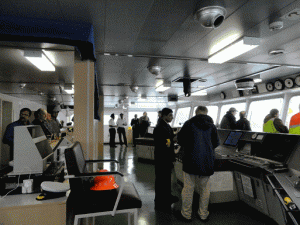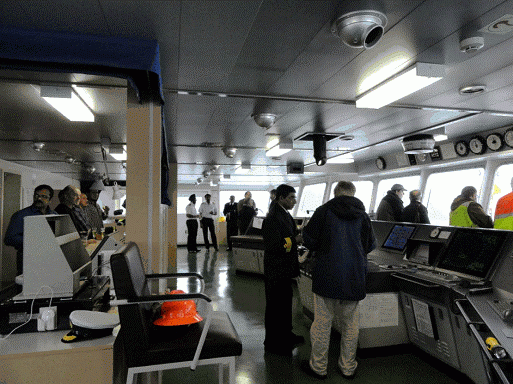Submitted by The Port of Olympia

Arrow with a visitor.
When the Macaw Arrow sailed into Budd Inlet last week, Port of Olympia was again proud to be the first port of call for a cargo ship on its maiden voyage. But this time the excited interest of port and maritime workers took a different direction. They were boarding a ship with the latest “green” features yet seen at the Olympia port.
Gearbulk, owner and manager of the Macaw Arrow, has been selling or recycling older, less efficient vessels and introducing larger, much more efficient vessels with fuel-saving technologies and economies of scale due to size.
The vessel’s engines and generators are designed to give higher fuel efficiency, reducing NOx emissions (nitric oxide and nitrogen dioxide). Weather routing and voyage optimization services further assist in achieving sailing routes that save time and save fuel, which in turn lessens the carbon footprint.
Macaw Arrow’s hull design maximizes cargo intake while maintaining low overall resistance through the water, resulting in lower fuel consumption and emissions. Flipper fins improve water flow into the propeller disc and improve propeller efficiency. Similarly, the rudder is fitted with a bulb directly behind the propeller which improves water flow and reduces frictional losses.
The underwater hull is coated with a low friction, anti-fouling paint which further reduces frictional resistance. It is also low in volatile organic compounds, meaning reduced emissions to the atmosphere.
The main engine is electronically controlled (rather than having a conventional camshaft controlling the fuel and valve timing functions). This gives much better combustion control over a wide load range which improves fuel efficiency (lower emissions) and gives smokeless exhaust (reduces particulate matter).
Also, the engine is de-rated, meaning it is slightly bigger than necessary, and is permanently operated at a reduced power and lower rpm which enables a more efficient propeller to be fitted, resulting in more fuel savings.
On all Gearbulk vessels, fuel flow meters and shaft torque meters monitor performance and provide the ability to intervene very quickly in the event of less than optimal performance. This is backed up with sophisticated software to help solve the problem.
An important feature of the Macaw Arrow is its ballast water treatment system which is designed to stop the spread of non-indigenous species. The fully integrated bridge has an electronic chart display and information system that eliminates the need for paper charts. The vessel’s garbage is segregated in compliance with Garbage Management Regulations and only food waste is discharged overboard. A comminutator is fitted on board for comminuting food waste. The Mariner Shilling Hi-lift rudder can go to a maximum angle of 70 degrees, giving the vessel a high turning rate.
Gearbulk is active in the SSI (Sustainable Shipping Initiative). The company is fully accredited with ISO 14001 certification, the environmental standard, in all its branch offices. This year its fleet management and its owned fleet will achieve ISO 14001 certification. In February, the Vancouver office was audited and passed the certification without any non-compliance.
The company’s Environmental Management System drives continual improvement toward its targets, which include: Reduce the company’s CO2 index by 20% from the 2010 level by the end of 2015, improve dunnage recycling, improve recycling of web slings, reduce office energy consumption.




















































